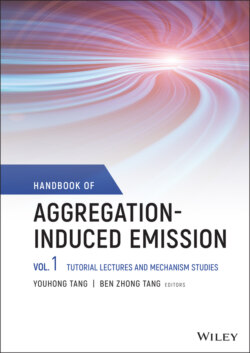Читать книгу Handbook of Aggregation-Induced Emission, Volume 1 - Группа авторов - Страница 22
1.5 Suppression of Kasha’s Rule
ОглавлениеFor classical luminophores, the internal conversions from higher excited states to the lowest excited states are much faster than the luminescence processes due to the rigid structures and large conjugation even in the gas phase or dilute solution, so the light emission always comes from the lowest excited state with a given spin multiplicity [20].
However, most AIEgens possess highly flexible structures with substantial low‐frequency molecular motions that are sensitive to the environmental constraints. The vigorous molecular motions will contribute to the coupling and mixing of multiple excited states. Once the relevant molecular motions are restricted in the aggregate or solid state, it is possible that the excitons can be stabilized in higher excited states and generate anti‐Kasha light emissions.
Qian et al., first, proposed the suppression of Kasha’s rule (SOKR) as the mechanism for the AIE behaviors of molecular rotors based on the boron‐difluorohydrazone (BODIHY) [11a]. The luminescence properties related to higher excited states of the BODIHY derivatives in the solution have been studied through the spectroscopy by changing the viscosity of the solution and varying the excitation wavelength. These derivatives show viscosity‐dependent emission enhancement but nearly no response to the solution polarity due to weak partial charge transfer. According to the calculation at the TDA‐PBE level, the first excited state is designated as a dark state. Instead, the S3 state is a bright state, which is more populated due to the relatively large energy gap between the S3 and lower excited states. It is demonstrated that once the viscosity increases, the rotation of the phenyl rings can be hindered and make the excitons stabilized in the higher excited state to generate enhanced anti‐Kasha emission. However, these results still remain controversial. Zhou et al. have recently employed more DFT functions to recheck the excited‐state properties of the BODIHY derivatives and have challenged the SOKR mechanism [11b]. They have found that the TDA‐PBE method used in Ref. [11a] may not describe the correct order of the excited states, and the energy gaps between S3 and S2 states obtained from this method are small enough to generate efficient internal conversion from S3 and S2 states. Hence, the emission of BODIHY derivatives in higher viscosity may not be induced by the SOKR. Instead, they proposed that the restriction of access to the CI caused by the flip‐flop motion is responsible for the AIE behaviors of BODIHY derivatives.
Guo et al. has recently reported another luminogen named DMF‐BP‐PXZ with highly efficient light emission from the S2 state (Figure 1.9a, b) [11c]. According to the calculation, the S1 state is a transition‐forbidden dark state, and the internal conversion dominates the decay process in the solution due to the severe molecular motions, so the rapid internal conversion from S2 to S0 state, through the intermediate S1 state, quenches the light emission. However, its kIC from S2 to S0 can be suppressed by four orders of magnitude, and the fluorescence radiation rate can be enhanced in the solid state, which leads to the efficient light emission from S2 state to the ground state. In this regard, further experimental evidence for the stable population of higher excited states is still highly desired to solidify the claim on the anti‐Kasha emission, but the mechanism demonstrated earlier also belongs to the category of RIM, and it validates the wide reliability of the RIM mechanism.
Exciton population on the higher excited states can also occur in the triplet states. Taking the ClBDBT as an example (Figure 1.9c, d), it exhibits white‐light emission under UV light and persistent yellow afterglow in the room temperature [11d]. According to the calculated energy levels, T1 and T2 states are all lower than the S1 state in energy, which makes both T1 and T2 accessible for the exciton population coming from the S1 state. Furthermore, the T2 state mainly contains the (n,π*) transition character, which leads to a larger spin–orbit coupling (SOC) between T2 and the S0 and a higher radiative decay rate, whereas the T1 state contains more (π,π*) transition character. At room temperature, the small energy gap between T2 and T1 can promote the thermal population from T1 to T2. According to Boltzmann distribution, T2 has a smaller population than T1, but the faster radiative decay from T2 results in a balanced emission intensity from both T2 and T1 states. Thus, the combined anti‐Kasha blue light from T2 and the yellow light from T1 generate the efficient white‐light emission at room temperature.
In fact, it is also the RIM process in the crystal state that stabilizes the specific electronic structures of T2 and T1 and restricts the nonradiative decay from triplet states to the ground state, and then the balanced dual emission can be restored.
Figure 1.9 Molecular structure, calculated energy levels, fluorescence, and internal conversion rate constants of DMF‐BP‐PXZ in the (a) solution and (b) solid state.
Source: Adapted from Ref. [11c] with permission from John Wiley and Sons.
(c) Molecular structure, calculated energy levels, and (d) emission spectra of ClBDBT in the solid state.
Source: Adapted from Ref. [11d] with permission from Springer Nature.
